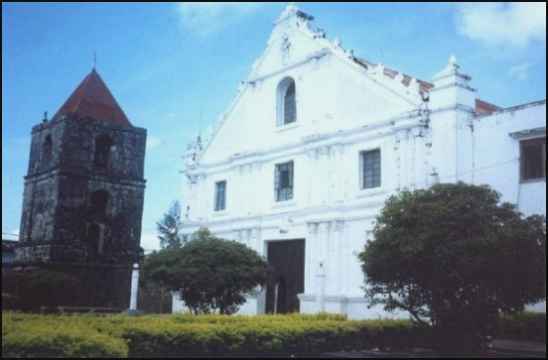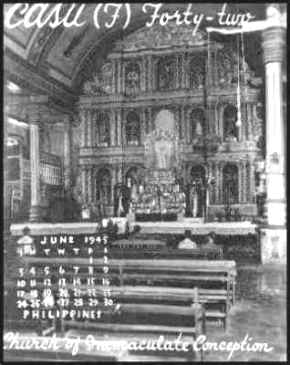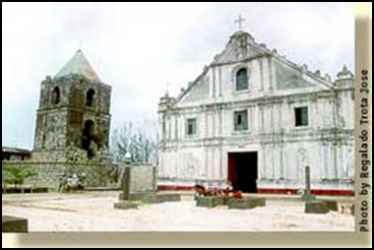
IMMACULATE CONCEPTION GUIUAN, EASTERN SAMAR, PHILLIPINES, 1945 |
 |
|
Photo Courtesy of Philwomenian |
|
by email from Elmer Garado - 9-4-03 I was exceedingly happy when I accidentally bumped into your article about the Immaculate Conception Church in Guiuan, Eastern Samar. I am a native of Guiuan and I am proud of my town. Recently, I have been eagerly looking for documents that could provide information about the role Guiuan played during the Spanish and American periods of Philippine history. I was lucky to have found two books telling about the indispensable role it played in my country's history. First was the discovery of the Philippines by the Portuguese traveler Ferdinand Magellan. Magellan saw the lofty mountains of Samar on March 16, 1521. The following day he and his crew landed on Homonhon, an island which is part of the territorial jurisdiction of Guiuan. During the early years of Spanish evengelization of the Philippine Islands, the Jesuits built a beautiful fortress church in Guiuan, the Immaculate Conception Church. Just like other oppulent pueblos in the Philippines, the Spaniards built stone fortification walls around the church complex. Delgado (1754, pp. 239-40), a Spanish author, aptly described the fort in Guiuan, to wit: "The fort of Guiuan is the best and most regularly planned in all the Visayas. It exceeds in grandeur the celebrated fort of Zamboanga. The Fathers with the aid of the townspeople built the fort for their defense.It was quadrilateral, each side being 70 brazas long. At every corner is a bulwark. On these bulwarks six pieces of artillery can be mounted. Within the fort, which is all of cut stone, stands the single naved church, large and capacious, and the house of the priest with all the necessary offices. It has four large patios, one serves as a cemetery and affords a commodious space for the schools. The other has a garden where a two-story warehouse stands. The kitchen is found in one of the bulwarks. On the bulwarks facing the sea are mounted six bronze cannons of various calibers, and a large one of iron, plus various lantacas, whipstaff, swivel guns, muskets and other arms which the ministers buy with the alms of the inhabitants. They also purchase gunpowder and bullets as an annual surety with which they can defend the town from any armed enemy attack." Today, however, only the southeastern and southwestern bulwarks and parts of the southern and western walls still stand, thanks to some unenlightened local officials and parish priests who had the other fortification walls destroyed to give way to some "improvements". Very recently the original parish house at the back of the church which was used as a school by the RVM Sisters was demolished.I am quite sad and disappointed at the blunder these people are doing to Guiuan's priceless heritage. I have formed a group of young professionals who are determined to see our heritage preserved for future generations of Guiuananons in particular, and Filipinos in general. We are looking for persons and/or organizations who can help us restore Guiuan's priceless treasures. I wonder how the old fort looked like, but an expert in the field of restoration work can bring back to us the fort which we were not able to see because of the blunder committed by some persons in the past. Although I don't know you, I mustered all the guts in me to write you, hoping that you could be of help to us in this endeavor. You may likewise know of some organizations which are into this kind of work. You could probably bring our cause to these organizations in America. It is worthy to note that the Jesuit mission to Guam and the Marianas was discovered through the mission in Guiuan. Although at one time or another, the Jesuits have touched upon these islands in the past, the return to these islands was fraught with danger. It was through some natives of Palau, who were cast adrift in Guiuan that the Jesuits found the route back to the islands. I think you are in a better position than me to talk about Guiuan during the Second World War. What I know is that it was once the site of the Navy 3149 Base. The airport built by the Americans is still occasionally being used today. But there is no commercial airline servicing the Guiuan route. I was surprised to know from historical accounts that three (3) days before General MacArthur landed on Red Beach, Palo, Leyte, his advance forces were already in Suluan, an island barangay/barrio of Guiuan. If you could share with us, your account as well as that of your comrades while they were still in Guiuan, we would be very happy to accept that. We, who belong to the younger generation of Guiuananons, want to know how it was in Guiuan during the war, how the people lived, and how the place looked like. It is our fervent hope that you would lend a hand to us. We would also like to thank you for the beautiful write up you made about our church in Guiuan. Thank you very much! Elmer M. Garado |
 |
 |
|
|
|
Photo Collection of Walter E. Lees |
Photo Courtesy of Philwomenian |
|
According to Walter's service record, he had left CASU (Carrier Aircraft Service Unit) 42 on 4 Jan 1945, so we weren't there at the same time, but it still seems like a small world to me! |
|
|
|
by Architect Augusto F. Villalon National Council for Culture and the Arts for allowing me to reproduce the photo and the story on this page |
 |
|
(Guiuan, province of Samar) Courtesy of National Commission for Culture and the Arts |
|
By Cyrain G. Cabueñas Inquirer News Service "GUIUAN, E. Samar -- Two 400-year-old life-size icons were reported missing from the Church of the Immaculate Conception here Tuesday, two days after this town's fiesta. Another statue had lost both hands, police said. Suspected thieves posing as ardent devotees fled with the bronze statue of St. Michael the Archangel and St. Roche and his dog, plus the ivory hands of St. Rita of Cascia..." To read the rest of this story, click on the title above. |
|
If you are interested in more general information on the Phillipines, you can go to the homepage by clicking on: |
 |
|
December, 2002 Photo Courtesy of Philwomenian |


|